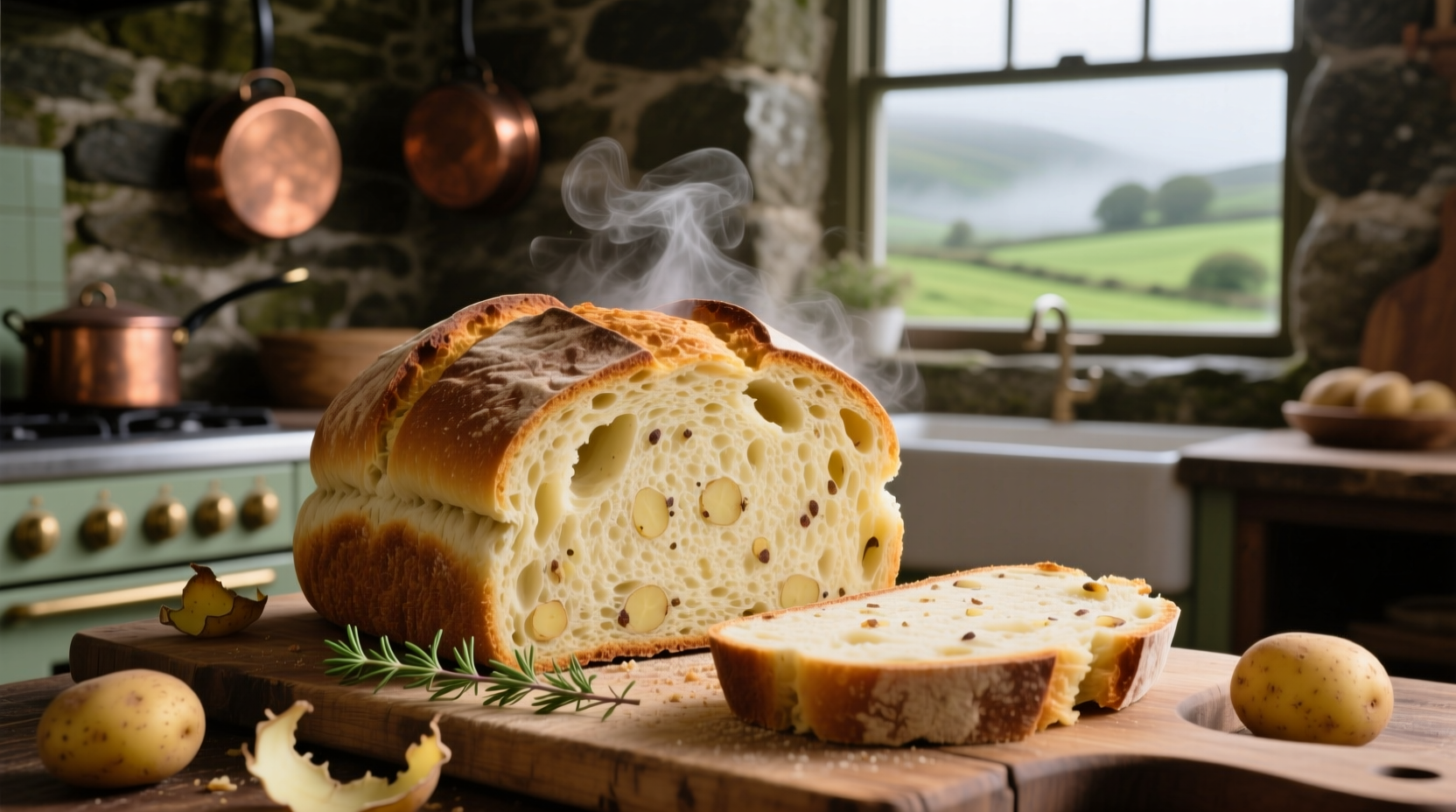For generations, Irish families have turned humble potatoes into comforting bread that transforms leftovers into something extraordinary. This simple yet versatile staple emerged during Ireland's difficult potato famine era when resourceful cooks found ways to stretch their most abundant crop. Today, it remains a beloved part of Irish culinary heritage, appearing on tables across the Emerald Isle and in Irish communities worldwide.
The Distinctive Character of Irish Potato Bread
What sets Irish potato bread apart from other potato-based breads? While American versions often incorporate potato flour for softness in sandwich bread, traditional Irish potato bread uses freshly mashed potatoes as the primary ingredient. This creates a unique texture—moist but not dense, with a slightly chewy crumb that holds up well with hearty stews and soups.
| Type of Potato Bread | Primary Potato Form | Texture Profile | Traditional Serving Context |
|---|---|---|---|
| Irish Potato Bread | Fresh mashed potatoes | Moist, slightly chewy | With meals as side bread |
| American Potato Bread | Potato flour/starch | Soft, tender crumb | For sandwiches |
| Irish Soda Bread | No potatoes | Dense, crumbly | Breakfast or with tea |
This comparison shows why understanding regional variations matters when searching for authentic Irish potato bread recipes. Many online recipes mistakenly conflate Irish potato bread with American-style potato bread or traditional Irish soda bread.
Historical Evolution: From Necessity to Tradition
The story of Irish potato bread is deeply intertwined with Ireland's relationship with the potato. Following the devastating potato famine of the 1840s, potatoes remained central to Irish cuisine but were used more creatively. Resourceful Irish cooks discovered that adding mashed potatoes to bread dough:
- Extended their limited flour supplies
- Created a more nutritious bread
- Provided better texture than plain flour breads
- Used leftover boiled potatoes effectively
According to historical records from the National Library of Ireland, potato-based bread recipes began appearing in Irish cookbooks by the late 19th century as families sought economical ways to incorporate their staple crop into daily meals. The National Library's Irish cookery collection documents how these recipes evolved from survival food to cherished tradition.

Essential Ingredients for Authentic Results
The magic of Irish potato bread lies in its simplicity. You need just five core ingredients, but each plays a crucial role:
Potatoes: The Heart of the Bread
Russet or Maris Piper potatoes work best—they're high in starch which creates the ideal texture. Never use pre-made mashed potatoes with butter or milk, as these alter the chemistry. The potatoes must be:
- Freshly boiled and riced (not mashed with liquid)
- Cooled to room temperature before mixing
- Accounting for 30-40% of the total dough weight
Flour Selection Matters
Traditional Irish recipes use soft wheat flour, which has lower protein content than American all-purpose flour. If using American flour, substitute 25% of the all-purpose flour with cake flour to mimic the Irish texture. This adjustment prevents the bread from becoming too chewy.
Step-by-Step Preparation Guide
Follow these steps for authentic Irish potato bread with perfect texture every time:
Preparation Phase (15 minutes)
- Boil 200g peeled potatoes until fork-tender
- Rice potatoes (don't mash) and cool completely
- Preheat oven to 220°C (425°F) with baking sheet inside
- Line a second baking sheet with parchment paper
Mixing and Shaping (10 minutes)
Combine in this exact order to prevent overworking:
- 300g flour + 1 tsp baking soda + 1 tsp salt (whisked)
- 200g cooled riced potatoes
- 240ml buttermilk (chilled)
Mix until just combined—overmixing creates tough bread. Shape into a 2cm thick round loaf. The dough should feel slightly sticky but hold its shape.
Baking for Perfect Results (20-25 minutes)
Transfer to preheated baking sheet. Bake until golden brown with hollow sound when tapped. Internal temperature should reach 96°C (205°F). Cool on wire rack for at least 20 minutes before slicing.
Troubleshooting Common Issues
Even experienced bakers encounter challenges with Irish potato bread. Here's how to address frequent problems:
Dense or Gummy Texture
Cause: Overmixing or warm potatoes melting the fat in the dough
Solution: Mix just until combined and ensure potatoes are completely cooled
Crumbly or Dry Bread
Cause: Too much flour or insufficient potato moisture
Solution: Measure flour by weight, not volume, and use high-starch potatoes
Insufficient Rise
Cause: Old baking soda or oven not properly preheated
Solution: Test baking soda freshness and use an oven thermometer
Serving Traditions and Modern Variations
Traditionally, Irish potato bread appears alongside:
- Hearty lamb or beef stews
- Boxty (Irish potato pancake) breakfasts
- Seafood chowders along the coast
- Simple meals with Irish butter and salt
Modern variations include adding:
- Chives or scallions for savory flavor
- Caraway seeds for traditional Irish taste
- Grated sharp cheddar for cheese potato bread
- Smoked paprika for color and depth
When storing, wrap cooled bread in a clean kitchen towel—never plastic, which traps moisture and creates sogginess. Properly stored, it stays fresh for 2-3 days at room temperature.











 浙公网安备
33010002000092号
浙公网安备
33010002000092号 浙B2-20120091-4
浙B2-20120091-4